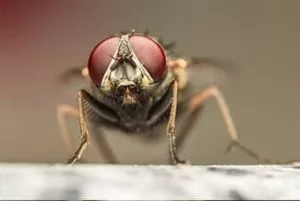At this time of year, I always expect it to be hard to find pest control topics to blog about since even East Tennessee’s relatively mild winters stop the majority of bug-related problems that homeowners in the area face. However, I’m always surprised to find that people have questions about pests during every month of the year because many pests don’t take much of a winter holiday. Over the past few weeks, I’ve had inquiries from friends about roaches, rodents, and spiders. But, the topic that took the cake was one that I didn’t expect: drain flies. I have heard from more than one person that drain flies (which include what we would often call gnats) are proving to be a problem in kitchens and bathrooms right now. So, let’s have a look at some likely culprits.
Drain flies (also known as moth flies) can crop up in any location where water stands for more than about a week without any movement. You are likely to notice the adults first. They’re very small with scaly wings that make them sort of dissolve into a feathery poof when you smash them. The larvae can survive nearly anywhere with moisture, but common breeding sites include floor drains in the garage, tanks for infrequently-used toilets, and trash cans that stay consistently damp.
Another common trouble-maker in this family is the fruit fly. Also known as red-eyed flies, these pesky invaders are pleased to feast on fruit on the counter that’s a little too ripe. They also like dirty garbage disposals, hair-filled bathroom drains, and trashcans. You can recognize them because they have small, brownish bodies and large bright red eyes.
These creatures are fairly unpleasant to share space with, but, quite often, getting rid of them is a quick process. All you need to do is locate their breeding site and clean it up! Of course, there are times when this is a tricky task since they frequent places that don’t often get attention from homeowners. However, we can direct you to some good starting places for your search.
Check your garbage cans first. A little pile of old food in the bottom is easy to blast out with the hose and could eliminate your entire problem. If those are all clean, try checking around your drains. If it’s not obvious at first whether the gnat problem is coming from a specific drain, run a little test. Take a disposable plastic cup of an appropriate size, coat the inside with cooking oil, and then place the cup over the questionable drain for a day. If you find drain flies stuck to the inside of the cup, you have just identified a problem area!
Russell’s Pest Control’s technicians know that prevention is a big part of keeping a pest-free* home. That’s why we promote the use of probiotic bio foam. This foam is loaded with eager little microbes (or good bacteria) that love to feast on decaying organic matter (which is also what those pests love to feast on). Putting bio foam in your drain allows the microbes to work on cleaning out the muck that is so appealing to the pests. Then, when the drain or trashcan is clean, the microbes die because there’s nothing left to eat. Unfortunately for the fruit flies, their food source and breeding site is gone as well. It’s a pretty handy method for cleaning up hard-to-reach areas like garbage disposals or bathroom drains.
Russell’s Pest Control can add bio foaming to a regular pest control service, or you can purchase bio foam from us and apply it yourself (this is allowed because the product doesn’t actually contain any chemicals, just microbes and citrus oil). Of course, if you want to do your own foaming, you should always read the label just as you would with any new cleaner. Contact us today to learn more!
Flushing Out The Drain Flies in Knoxville TN
Serving East Tennessee since 1971

